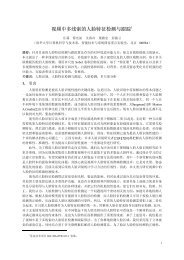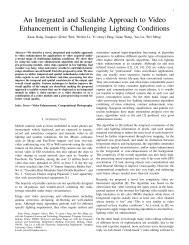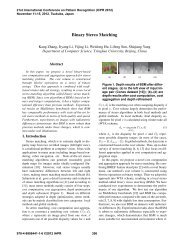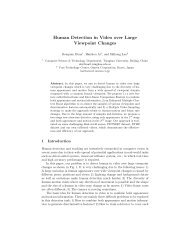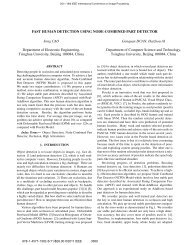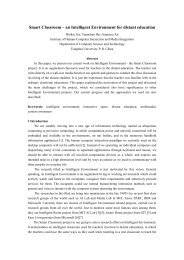An Efficient and Integrated Algorithm for Video Enhancement in ...
An Efficient and Integrated Algorithm for Video Enhancement in ...
An Efficient and Integrated Algorithm for Video Enhancement in ...
Create successful ePaper yourself
Turn your PDF publications into a flip-book with our unique Google optimized e-Paper software.
6<br />
fidelity level. The process of f<strong>in</strong>d<strong>in</strong>g the best match between<br />
a block to be encoded <strong>and</strong> a block <strong>in</strong> a reference frame is<br />
called “motion estimation”, <strong>and</strong> the “best” match is usually<br />
determ<strong>in</strong>ed by jo<strong>in</strong>tly consider<strong>in</strong>g the rate <strong>and</strong> distortion costs<br />
of the match. If a “best” match block is found, the current<br />
block will be encoded <strong>in</strong> <strong>in</strong>ter mode <strong>and</strong> only the residual will<br />
be encoded. Otherwise, the current block will be encoded <strong>in</strong><br />
<strong>in</strong>tra mode. The most commonly used metric <strong>for</strong> distortion <strong>in</strong><br />
motion estimation is the Sum of Absolute Differences (SAD).<br />
Fig. 11.<br />
Subsampl<strong>in</strong>g pattern of proposed fast SAD algorithm.<br />
10 x 107 Relative difference of t(x)<br />
Quantity<br />
9<br />
8<br />
7<br />
6<br />
5<br />
4<br />
3<br />
2<br />
encod<strong>in</strong>g. To this end, each P frame is divided <strong>in</strong>to nonoverlapp<strong>in</strong>g<br />
16 × 16 blocks, <strong>for</strong> which a motion search us<strong>in</strong>g<br />
the SAD is conducted. A threshold T is def<strong>in</strong>ed <strong>for</strong> the SAD<br />
of blocks: if the SAD is below the threshold which means<br />
a “best” match block is found, the calculation of t(x) <strong>for</strong><br />
the entire MB is skipped. Otherwise, t(x) still needs to be<br />
calculated. In both cases, the values <strong>for</strong> the current frame are<br />
stored <strong>for</strong> possible use <strong>for</strong> the next frame. The flow diagram<br />
is shown <strong>in</strong> Fig. 12. We call this acceleration algorithm as ME<br />
acceleration enhancement algorithm.<br />
1<br />
0<br />
0 0.1 0.2 0.3 0.4 0.5 0.6 0.7 0.8 0.9 1<br />
Fig. 10. Differences of t(x) values between the predicted block’s pixels’<br />
<strong>and</strong> its reference block’s pixels’.<br />
To verify the feasibility of us<strong>in</strong>g temporal block match<strong>in</strong>g<br />
<strong>and</strong> ME to expedite t(x) calculation, we calculated the differences<br />
of t(x) values <strong>for</strong> pixels <strong>in</strong> the predicted <strong>and</strong> reference<br />
blocks. The statistics <strong>in</strong> Fig. 10 shows that the differences are<br />
less than 10% <strong>in</strong> almost all cases. There<strong>for</strong>e, we could utilize<br />
ME/MC to accelerate the computationally <strong>in</strong>tensive calculation<br />
of t(x) <strong>and</strong> only needed to calculate t(x) of a few selective<br />
frames. For the non-critical frames, we used the correspond<strong>in</strong>g<br />
t(x) values of the reference pixels. To reduce the complexity<br />
of the motion estimation process, we used mature fast motion<br />
estimation algorithms e.g. Enhanced Prediction Zonal Search<br />
(EPZS) [16]. When calculat<strong>in</strong>g the SAD, similar to [17] <strong>and</strong><br />
[18], we only utilized a subset of the pixels <strong>in</strong> the current<br />
<strong>and</strong> reference blocks us<strong>in</strong>g the pattern shown <strong>in</strong> Fig. 11. With<br />
this pattern, our calculation “touched” a total of 60 pixels <strong>in</strong><br />
a 16 × 16 block, or roughly 25%. These pixels were located<br />
on either the diagonal or the edges, result<strong>in</strong>g <strong>in</strong> about 75%<br />
reduction <strong>in</strong> SAD calculation when implemented <strong>in</strong> software<br />
on a general purpose processor.<br />
In our implementation, when the proposed algorithm is<br />
deployed prior to video compression or after video decompression,<br />
we first divide the <strong>in</strong>put frames <strong>in</strong>to GOPs. The GOPs<br />
could either conta<strong>in</strong> a fix number of frames, or decided based<br />
on a max GOP size (<strong>in</strong> frames) <strong>and</strong> scene chang<strong>in</strong>g. Each<br />
GOP starts with an Intra coded frame (I frame), <strong>for</strong> which all<br />
t(x) values are calculated. ME is per<strong>for</strong>med <strong>for</strong> the rema<strong>in</strong><strong>in</strong>g<br />
frames (P frames) of the GOP, similar to conventional video<br />
Calculate<br />
airlight A<br />
Calculate<br />
t(x)<br />
Is low light<strong>in</strong>g<br />
no<br />
I frame<br />
Recover<br />
J(x)<br />
Output<br />
yes<br />
Invert<br />
no<br />
P frame<br />
EPZS ME<br />
Is <strong>in</strong>ter-mode<br />
block<br />
Calculate t(x)<br />
of the block<br />
yes<br />
Assign reference<br />
block’s t(x)<br />
Fig. 12. Flow diagram of the core enhancement algorithm with ME<br />
acceleration.<br />
In addition to operat<strong>in</strong>g as a st<strong>and</strong>-along module with<br />
uncompressed pixel <strong>in</strong><strong>for</strong>mation as both the <strong>in</strong>put <strong>and</strong> output,<br />
the ME accelerated enhancement algorithm could also be<br />
<strong>in</strong>tegrated <strong>in</strong>to a video encoder or a video decoder. When the<br />
algorithm is <strong>in</strong>tegrated with a video encoder, the encoder <strong>and</strong><br />
the enhancement can share the ME module. When <strong>in</strong>tegrated<br />
with the decoder, the system has the potential of us<strong>in</strong>g the<br />
motion <strong>in</strong><strong>for</strong>mation conta<strong>in</strong>ed <strong>in</strong> the <strong>in</strong>put video bitstream<br />
directly, <strong>and</strong> thereby by-pass<strong>in</strong>g the entire ME process. Such<br />
<strong>in</strong>tegration will usually lead to a RD loss. The reason <strong>for</strong><br />
this loss is first <strong>and</strong> <strong>for</strong>emost that the ME module <strong>in</strong> the<br />
encoder with which the enhancement module is <strong>in</strong>tegrated or



